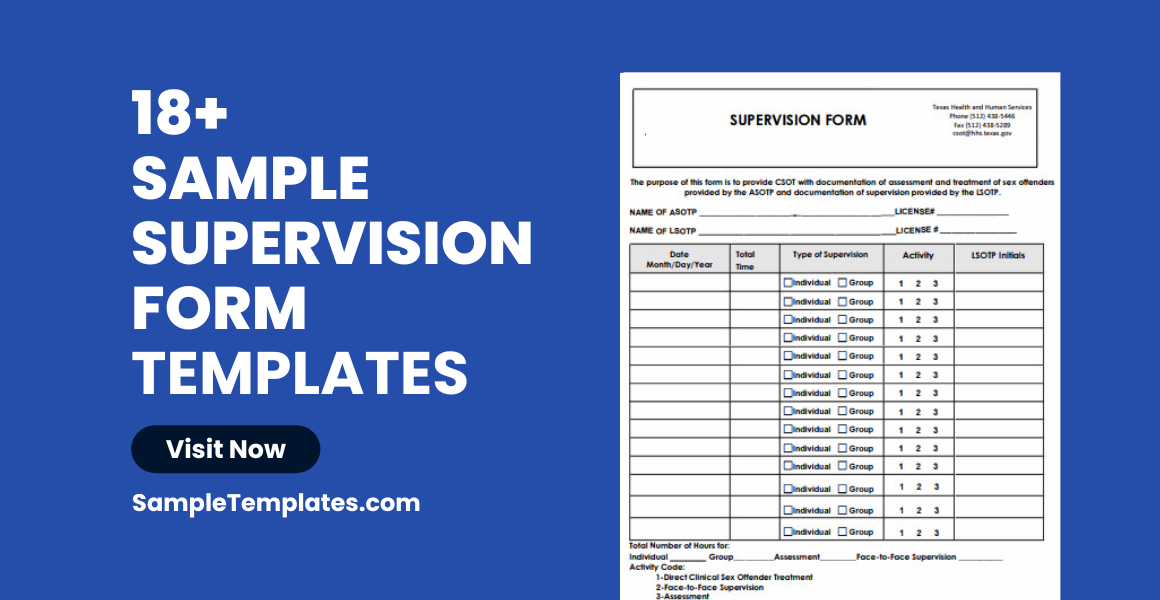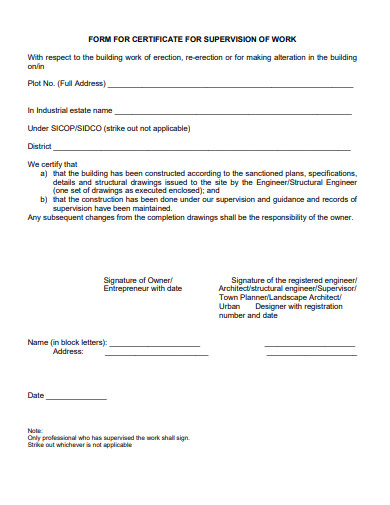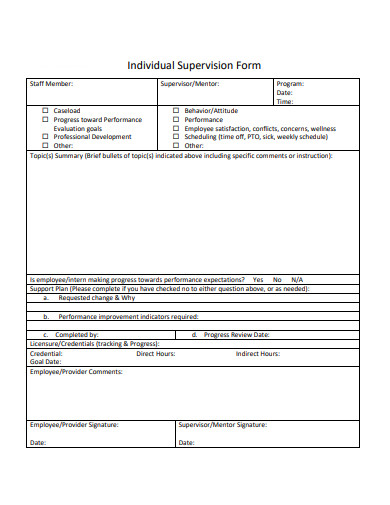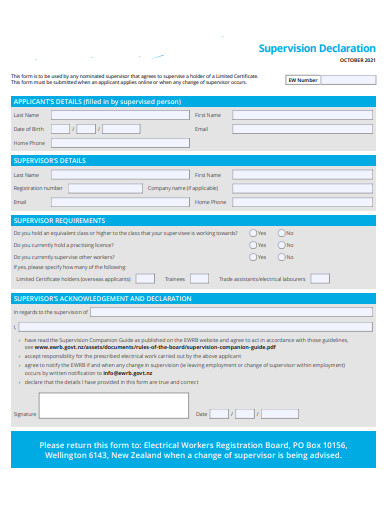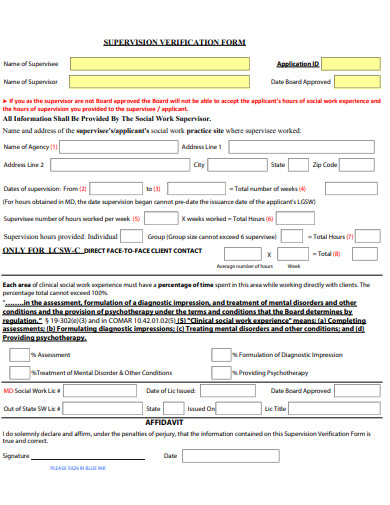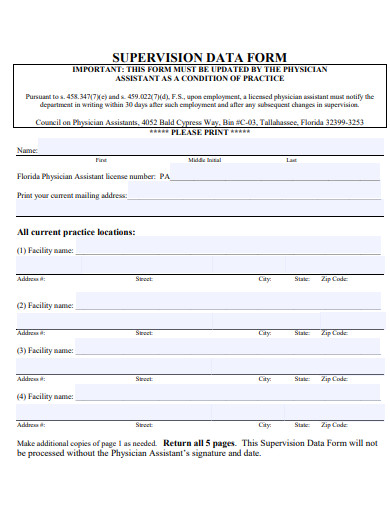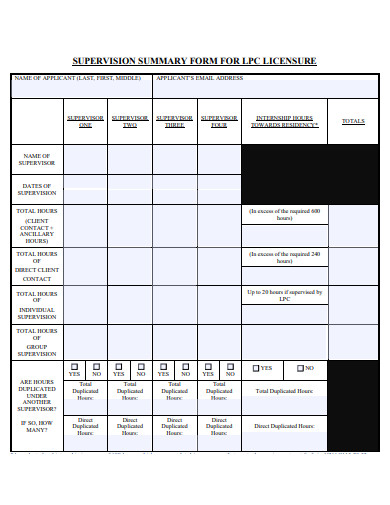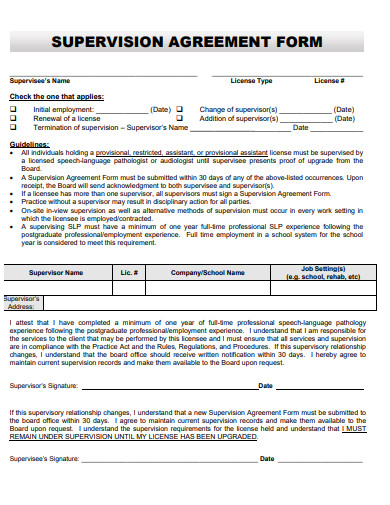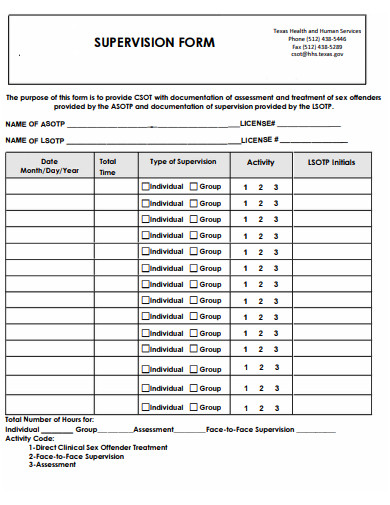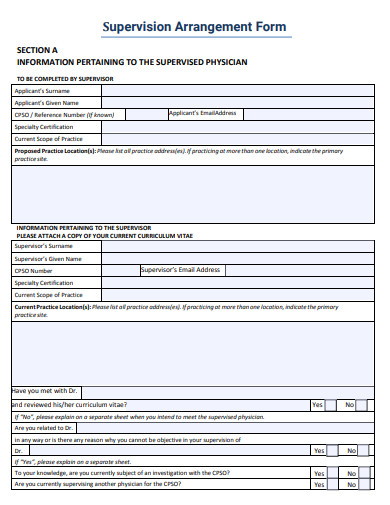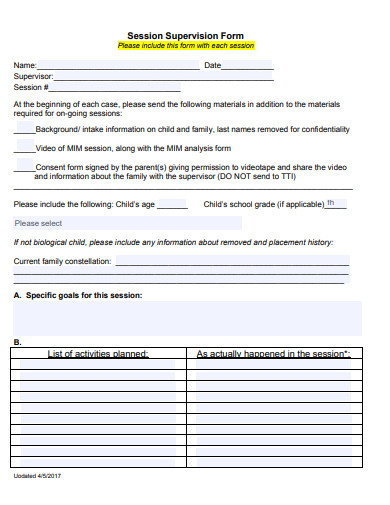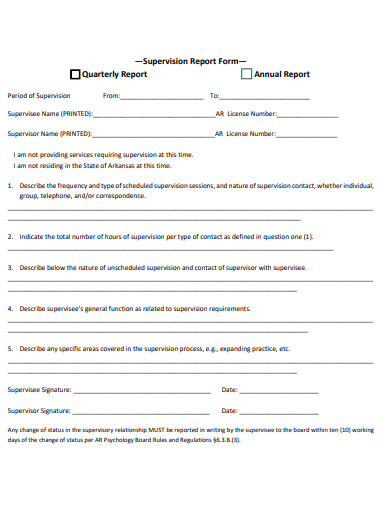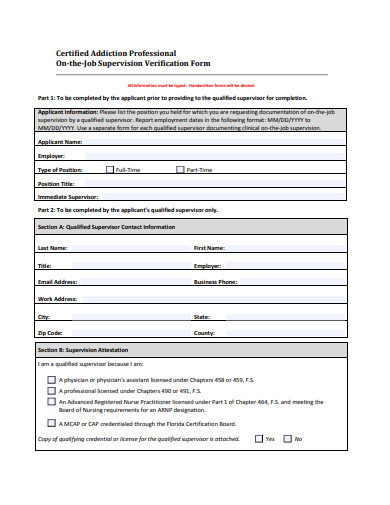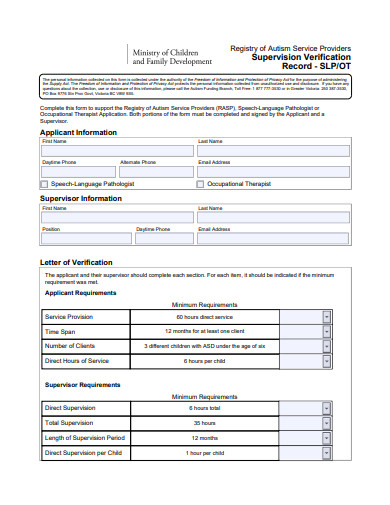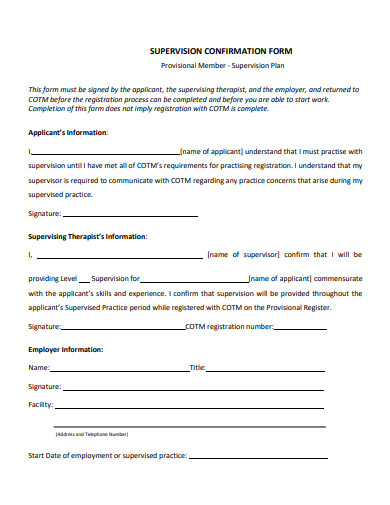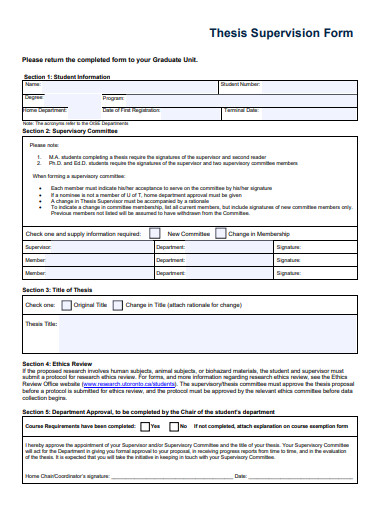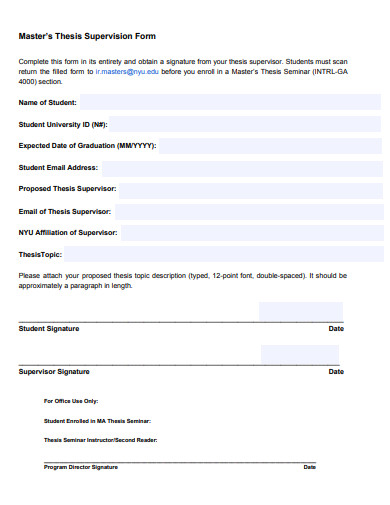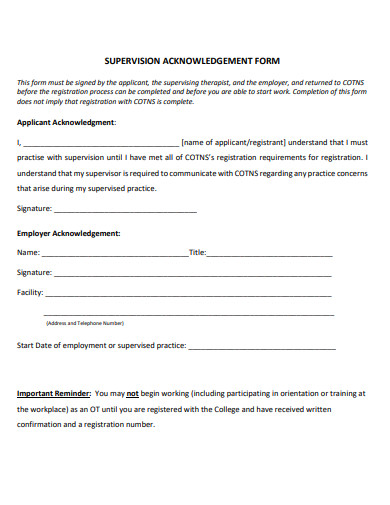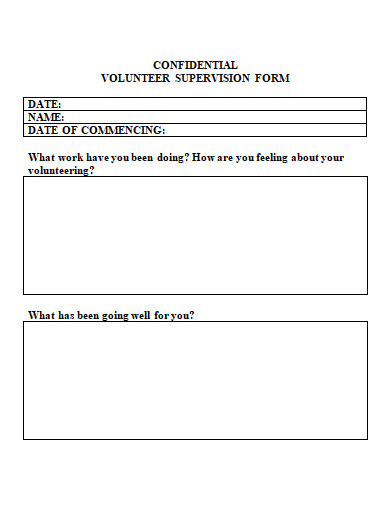Every successful project or task demands effective oversight. A ‘Supervision Form’ serves as an essential tool in this quest, ensuring that activities are monitored and standards met consistently. Rooted in a foundation of accountability, these sample forms bridge the gap between management and execution. Whether you’re a seasoned manager or a frontline supervisor, incorporating this tool can revolutionize the way you handle tasks and lead teams. Dive in to understand its importance and how it can optimize your supervisory practices.
18+ Supervision Form Samples
1. Supervision of Work Form Template
2. Sample Individual Supervision Form Template
3. Sample Supervision Declaration Form Template
4. Sample Supervision Verification Form Template
5. Sample Supervision Data Form Template
6. Sample Supervision Summary Form Template
What is a Supervision Form?
A supervision form is a tool used by supervisors and managers to record, track, and assess the performance, development, and sample feedback of employees, trainees, or students. These forms play a critical role in various settings, such as academic institutions, corporate environments, and healthcare facilities, ensuring that individuals receive the right guidance and feedback to enhance their skills and achieve their sample goals.
Importance of Supervision Forms
- Performance Evaluation: Supervision forms help in gauging the performance levels of an employee. This ensures that both the supervisor and the supervisee are on the same page regarding performance expectations and achievements.
- Feedback Mechanism: Through these forms, employees or students can receive constructive feedback, enabling them to understand their areas of strength and those that need improvement.
- Training and Development: Identifying training needs becomes simpler when there’s a record of areas where an individual may be lacking. This ensures that resources are channeled effectively to improve skills.
- Documentation: In scenarios of disputes or disagreements, having a written record sheet can be invaluable. Supervision forms offer a sample paper trail of evaluations, feedback, and comments.
Components of a Supervision Form
- Personal Details: This section typically includes the name, position, department, and other essential details of the person being supervised.
- Evaluation Period: Defines the timeframe for which the sample assessment is being made. It can be monthly, quarterly, annually, or any other specified period.
- Performance Indicators: These are specific metrics or criteria against which the individual’s performance is measured. Examples might include job knowledge, quality of work, punctuality, teamwork, and communication skills.
- Ratings Scale: Most forms include a scale (e.g., 1-5 or Poor to Excellent) to grade each performance indicator.
- Feedback Section: A space dedicated for supervisors to write specific comments, suggestions, or observations.
- Goals and Objectives: An area where future targets, aspirations, or improvement areas are noted for the supervisee.
- Signatures: Both the supervisor and the supervisee typically sign the form, acknowledging the feedback and evaluations made.
Best Practices for Using Supervision Forms
- Consistent Use: Ensure that these forms are used regularly and not just sporadically. Regular evaluations give a clearer picture of performance and growth.
- Open Communication: The form should be a starting point for open dialogue between the supervisor and supervisee. It shouldn’t just be a one-way feedback mechanism.
- Training for Supervisors: Those in charge of filling out the forms should be trained to give constructive feedback, avoiding biases and being sample objective in their evaluations.
- Review and Update: As roles evolve and industries change, the criteria for evaluation might also need to change. Regularly updating the supervision form to reflect these changes is crucial.
- Confidentiality: Ensure that the information on the supervision form is kept confidential and is shared only with the concerned parties.
The Future of Supervision Forms
With the advent of technology, many organizations are moving away from paper-based forms to digital platforms. These platforms allow for real-time feedback, easier storage and retrieval, and the integration of performance metrics with other HR systems. The essence, however, remains the same: to provide a structured way of evaluating, guiding, and improving the skills and performance of individuals.
The Three Forms of Supervision are
- Direct Supervision: This is where the supervisor is physically present and actively oversees the work or tasks being performed by the supervisee. It’s often used in settings where immediate feedback is necessary or where the tasks being performed are critical or high-risk.
- Indirect Supervision: In this form, the supervisor is not constantly present while the work is being done but is available for consultation or guidance as needed. The supervisee has more independence but knows that support or direction can be sought when necessary.
- Reflective Supervision: This form focuses on the plan of professional development of the supervisee. It’s a collaborative process where both the supervisor and supervisee reflect on the work done, discussing experiences, feelings, and professional challenges. It’s common in professions like counseling or therapy, where understanding one’s reactions and feelings is crucial to the job.
7. Sample Supervision Feedback Form Template
8. Sample Supervision Agreement Form Template
9. Sample Printable Supervision Form Template
10. Sample Supervision Arrangement Form Template
11. Sample Session Supervision Form Template
12. Sample Supervision Report Form Template
13. Sample On-the-Job Supervision Verification Form Template
14. Sample Supervision Verification Record Form Template
15. Sample Supervision Confirmation Form Template
16. Sample Thesis Supervision Form Template
17. Sample Masters Thesis Supervision Form Template
18. Sample Supervision Acknowledgement Form Template
19. Sample Volunteer Supervision Form Template
What do you Write in Supervision Form?
In a supervision form, you typically write:
- Personal Details: Name and position of supervisee and supervisor.
- Evaluation Period: Timeframe being assessed.
- Performance Indicators: Criteria or tasks for evaluation.
- Rating: Grading based on performance.
- Comments: Feedback on performance.
- Areas for Improvement: Points needing enhancement.
- Goals: Targets for the next session.
- Training Needs: Recommended courses or resources.
- Agreed Actions: Steps to take based on feedback.
- Signatures: From both supervisee and supervisor.
How do you Create a Supervision Form?
Whether you’re in a corporate setting, a non-profit organization, or an educational institution, effective supervision is critical for ensuring quality, fostering professional development, and addressing issues. One tool that greatly aids in this process is a supervision form. You can also see more templates like Approval Form Samples. Here’s a concise, step-by-step guide to creating one:
1. Determine the Purpose and Scope
Before diving into the design of your form, it’s essential to define what you intend to achieve with it. Is the form meant for routine supervision of tasks, performance evaluation, or feedback collection? Understanding the purpose will shape the content and structure of your form. Additionally, decide on the scope – whether it’s for a specific project, a particular department, or the entire organization.
2. List Essential Information Fields
Every supervision form should begin with some basic fields to identify the supervisee, supervisor, date, and any other relevant identifiers. This ensures clarity in record-keeping and avoids confusion later on. For example, fields might include:
- Supervisee Name
- Supervisor Name
- Department/Project
- Date of Supervision
- Duration of Supervision
3. Develop Evaluation Criteria
Depending on your form’s purpose, you’ll need to outline specific criteria for evaluation. If it’s a performance evaluation form, you might have scales like “Exceeds Expectations,” “Meets Expectations,” and “Needs Improvement.” For routine supervision, it could be more binary, such as “Completed” or “Not Completed.” For feedback, it might be open-ended questions or a Likert scale. When developing criteria:
- Ensure they align with organizational objectives.
- Make them clear and specific to avoid ambiguity.
- Consider involving both supervisors and supervisees in criteria development for a more holistic approach.
4. Include Space for Comments and Feedback
Beyond checkboxes and scales, it’s beneficial to have a section where supervisors can provide qualitative feedback or additional comments. This space allows for more in-depth insights, suggestions for improvement, or recognition of exemplary work. It also offers supervisees an avenue to share their thoughts, concerns, or reflections about the supervision process or their performance.
5. Design for User-Friendliness
A form is only as good as its usability. Ensure your supervision form is clear, logically ordered, and not overly lengthy. Consider the following design tips:
- Group related items or criteria together.
- Use a clean, readable font and provide adequate spacing.
- Offer a mix of checkboxes, scales, and open spaces to cater to different types of feedback.
- If possible, test the form with a small group before finalizing. Their feedback can be invaluable in refining the design.
What is a Staff Supervision Form?
A Staff Supervision Form is a document used by managers or supervisors to record, assess, and provide feedback on an employee’s performance and development. It serves as a structured tool to facilitate regular communication between supervisors and their staff, ensuring clear understanding of performance expectations, areas of improvement, and future goals.
In conclusion, supervision forms are integral tools in the growth and development of employees, students, or any individuals in a structured setting. They offer a systematic way of tracking performance, providing feedback, and setting future goals. As with any tool, their effectiveness lies in how they are used – with fairness, consistency, and a genuine desire to see individuals succeed and grow. You can also see more templates like Registration Form Samples.
Related Posts
Sample Sworn Affidavit Forms
Vehicle Inspection Forms Samples & Templates
Sample Employee Advance Forms
Sample Child Travel Consent Forms
Sample Testimonial Request Forms
Sample Employee Details Forms
Sample Divorce Forms
Sample Attestation Forms
Employee Performance Appraisal Form Templates
FREE 9+ Sample Presentation Evaluation Forms in MS Word
FREE 10+ School Admission Form Samples & Templates in MS Word | PDF
FREE 30+ Patient Consent Form Samples in PDF | MS Word
FREE 10+ Sample Sign Off Form Templates in PDF | MS Word
FREE 11+ Sample Medical Consultation Forms in PDF | MS Word
FREE 8+ Sample Donation Forms in PDF | MS Word
